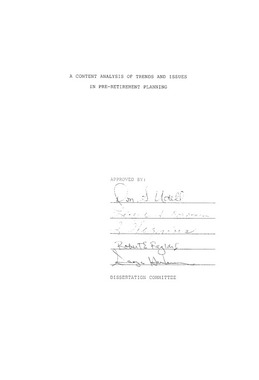| dc.contributor.author | Waters, Nancy Best, | en_US |
| dc.date.accessioned | 2013-08-16T12:29:15Z | |
| dc.date.available | 2013-08-16T12:29:15Z | |
| dc.date.issued | 1984 | en_US |
| dc.identifier.uri | https://hdl.handle.net/11244/5276 | |
| dc.description.abstract | All eleven subject content categories were differentially emphasized in ten pre-retirement planning manuals analyzed in this study. Additional research is clearly indicated to access conceptual emphases and trends in other media components of pre-retirement planning. Adult educators should present balanced and realistic presentations of aging issues to equalize opportunity for life satisfaction among all consumers of pre-retirement planning. | en_US |
| dc.description.abstract | The problem of the study was to describe and compare conceptual emphases in pre-retirement planning through examination of subject content in ten selected pre-retirement planning manuals commercially produced in the United States from 1972 through 1983. To analyze change in subject content emphases over time, the manuals were grouped into two time intervals, 1972 through 1977 and 1978 through 1983. The Analytic Content Schema (Lowry, 1979) was adapted for coding the text of each manual into one of eleven subject content categories: bio/physiological, economic, health, psychological, social, occupational, leisure/cultural, educational, political/legal, spiritual, and miscellaneous. | en_US |
| dc.description.abstract | The data indicate that the subject content emphases differed significantly between categories. When subject content categories were compared between time intervals, significant differences were found. The manuals under investigation presented a conceptual bias in content emphases dominated by economic, bio/physiological, and health issues while education and spiritual issues were least emphasized. Only two categories, political/legal and occupational issues, significantly increased in emphasis from Time Interval I (1972 through 1977) to Time Interval II (1978 through 1983). | en_US |
| dc.description.abstract | Data to measure subject content frequency were derived from all designated text using mean words per line of text as the unit of enumeration. Coders read and classified text from each manual yielding 548,422 total mean words. Subject content frequency for each manual was converted to ranks and a two-way analysis of variance with manuals as nested groups was employed to determine significantly different subject content emphases. Each subject content category was utilized as a treatment group. Multiple comparisons were performed to identify differences between subject content categories and over time intervals. | en_US |
| dc.format.extent | vii, 64 leaves ; | en_US |
| dc.subject | Education, Adult and Continuing. | en_US |
| dc.title | A content analysis of trends and issues in pre-retirement planning / | en_US |
| dc.type | Thesis | en_US |
| dc.thesis.degree | Ph.D. | en_US |
| dc.thesis.degreeDiscipline | Jeannine Rainbolt College of Education | en_US |
| dc.note | Source: Dissertation Abstracts International, Volume: 45-07, Section: A, page: 1960. | en_US |
| ou.identifier | (UMI)AAI8424000 | en_US |
| ou.group | Jeannine Rainbolt College of Education | |
